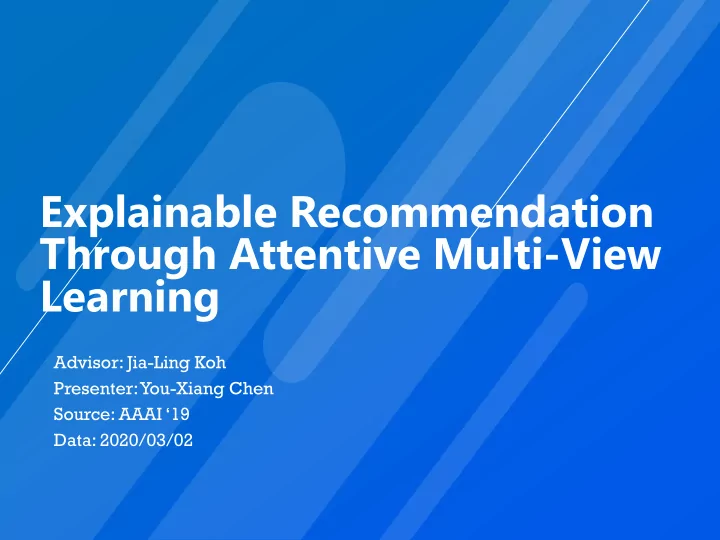

Explainable Recommendation Through Attentive Multi-View Learning Advisor: Jia-Ling Koh Presenter: You-Xiang Chen Source: AAAI ‘19 Data: 2020/03/02
Content 01 Introduction 02 Method 03 Experiment 04 Conclusion
Introduction
Introduction Recommendation System
Introduction Matrix Factorization item latent × item feature user feature × user latent
Introduction Neural Collaborative Filtering Deep but unexplainable
Introduction We propose a Deep Explicit Attentive Multi-View Learning Model (DEAML) for explainable recommendation: 1. improves accuracy from noisy and sparse data 2. formulates personalized explanation generation as a constrained tree node selection problem
Problem Definition Microsoft • Input Concept Graph • User set 𝑉 • Item set 𝐽 • Explicit feature hierarchy Υ • Set the node in Υ as ℱ = {ℱ 1 , … , ℱ 𝑀 } e.g. Pork • Output • Predicted rating Ƹ 𝑠 𝑗𝑘 • Feature-level explanation 𝐹 (𝑡𝑣𝑐𝑡𝑓𝑢 𝑝𝑔 𝐺)
Microsoft Concept Graph • 5 million concepts • 85 million “ IsA ” relations • New York (is-a) state • Name (is-a) information • Facebook ( (is-a) social medium https://concept.research.microsoft.com/
Relate work Explicit Factor Models for Explainable Recommendation based on Phrase-level Sentiment Analysis • Explicit Factor Models Enrich user & item representation by adding set of latent factors learned from explicit feature . explicit factor explicit factor capture both explicit & implicit factor
Relate work Explicit Factor Models for Explainable Recommendation based on Phrase-level Sentiment Analysis • User/Item-feature attention matrix 𝒀, 𝒁 ℱ = ℱ 1 , … , ℱ 𝑞 , set of explicit feature in review X, Y are in the range of [𝟐, 𝐎] • Integrating Explicit and Implicit Features 𝑊 𝑈 : projection matrix Factorization Model over matrix 𝒀 , 𝒁 Factorization Model over matrix A
Method
Framework Deep Explicit Attentive Multi-View Learning Model
Hierarchical propagation • Personalized User Attention Attn. score 𝒚 𝒋𝒎 measures how much user 𝒋 cares about feature 𝑮 𝒎
Attentive Multi-View Learning • Latent factors learning from explicit features concatenation user representation at view h Latent factor learn from explicit feature (EFM model) Latent factor learn from implicit feature (EFM model) item representation at view h h=1 rating prediction in h view
Attentive Multi-View Learning projection matrix • Loss of each view rating prediction for each view estimating hidden representation of user/item • Co-regularization loss enforcing agreement
Attentive Multi-View Learning • Weighted sum prediction in each view Calculate attention weight
Objective function • Jointly learning loss of each view Co-regularization loss Weighted sum prediction
Personalized Explanation Generation • Utility function user interest at level h item interest at level h weight of view h 5 6 -1 4 2
Personalized Explanation Generation • Constrained tree node selection max. utility of s-th child max. utility (s-1)-th node to t’
Experiment
Dataset • Statistics of the evaluation datasets Dataset User# Item# Reviews# Toys&Games 19,412 11,924 167,597 5-core Digital Music 5,541 3,568 64,706 5-core Yelp 8,744 14,082 212,922 10-core
Baselines • Observed rating matrix • NMF • PMF PMF • SVD++ • Knowledge-based method • CKE • Reviews-based method • HFT HFT • EFM EFM Single layer structure • DeepCoNN Deep learning base • NARRE
RMSE comparison same weight to all views
Effect of number of latent factors
Case Study
Conclusion 1. We build an initial network based on an explainable deep hierarchy (Microsoft Concept Graph) and improve the model accuracy by optimizing key variables in the hierarchy 2. We propose a Deep Explicit Attentive Multi-View Learning Model (DEAML) for explainable recommendation, which combines the advantages of deep learning-based methods and existing explainable methods. 3. Experimental results show that our model performs better than state-of-the- art methods in both accuracy and explainability.
Recommend
More recommend